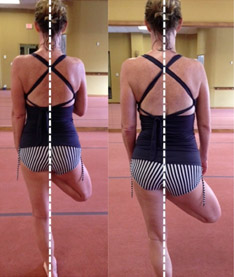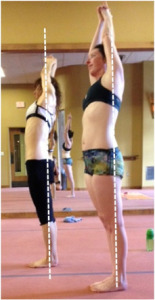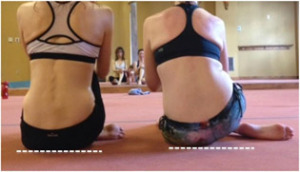 When we teach this wonderful healing yoga, you will often hear us tell you to put “two hips in one line.” You may wonder what that means.
When we teach this wonderful healing yoga, you will often hear us tell you to put “two hips in one line.” You may wonder what that means.
Two hips in one line translates to alignment on a variety of planes. For example, in Standing Separate Leg Head to Knee, we encourage you to turn your hips, 1, 2, 3, 4, 5 times to get two hips in one line.
That one line is the saggital plane, assuming, of course, your hips are already on the transverse and coronal planes.
Hold on, let me back up a bit. There are three planes that we refer to (but never mention directly) when we teach yoga—the saggital, coronal and transverse planes.
Alignment on these planes, to the best of your ability, is what will help you to stretch muscles and develop strength equally and appropriately.
The coronal plane is your body’s ability to maintain alignment from right to left. So as you bend to the right in half moon pose, you are working to stay in the coronal plane.
Another way to look at it is to think of your body between two plates of glass—as you come into half moon, no part of your body is pushing against the glass plates, you are gliding smoothly between them. That’s staying in the coronal plane.
Two hips in one line, in this example, mean that your hips should be square to the mirror to stay on the coronal plane. Look at the photo of Taka and Laura—see how Laura’s hips are twisted out of alignment?
From the side you can see how her two hips are not in one line. You cannot see Taka’s right hip at all; she is in coronal alignment.
The saggital plane is your body’s ability to maintain alignment from the center line of your body. In your mind, take those two plates of glass and shift them to your right and left side.
In tree pose, for example, when you pick up your right foot, make sure that you don’t shift your hips to the left, thus leaning into one plate of glass.
Shifting weight is easy to do, and it helps you to counterbalance, but it brings your body out of the saggital plane.
Just like in the half moon example above, the goal is to avoid pushing or leaning into the glass. Keep two hips in one line by continually stretching upward, engaging your core abdominal muscles and contracting the quads.

Left photo shows hips correctly in the saggital plane; right side demonstrates hips out of alignment.
In the example on the right, you can see how my hips are not in one line. In fact my whole body is tilted to the left side—see how my left leg crosses into the white line?
The goal is to create alignment closer to the image on the left so there is a mirror image on either side of the center line of the body.
The transverse plane is your body’s ability to stay level. The plate of glass just moved to the floor.
In spine twist, for example, it’s important to keep your both hips on the floor to maintain integrity in the transverse plane.
When one hip comes off the floor, your transverse plane is compromised and that compromise extends up through the entire spinal column!
When we refer to the transverse plane, we are usually using the term “level” to keep you in alignment.
In the photo example here, Laura on the right has her right hip off the transverse plane—and look how it affects her whole alignment structure.
She’s also out of alignment from the saggital plane—see how her spine is crooked? Because Taka’s hips are both on the floor, the rest of her body is better aligned.
Who would have thought that two hips in one line could have such important meaning?
As you practice for the next few weeks, focus on your alignment in the coronal, saggital and transverse planes.
Work to get your hips square and level during the setup, the full expression of the pose and the dismount. And two hips in one line will bring a whole new awareness to your practice!
Questions about two hips in one line? Questions about alignment? Come to the Yoga Lab on Saturdays! Alignment is only one thing we’ll discuss! We’ll see you there!



